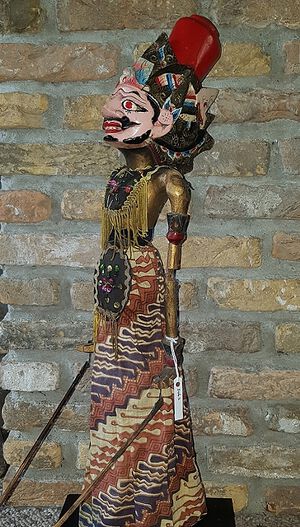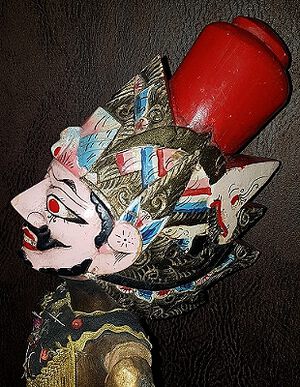Baladewa
| Title | Baladewa - (Prabu) - Mahabharata |
|---|---|
| Other names | Alayuda, Balarama, Basukiyana, Aladara (as hermit), Jaladara, Kusumawalikita, Sangkarsana, Kakrasana (young), Langalin, Seta, Hali, Mandura |
| Size | 60 cm |
| Personal data | Prabu Baladewa, who in his youth was called Kakrasana, was the son of Prabu Basudewa, the king of Mandura with his queen Dewi Mahendra/Maekah (Java). Baladewa was born as a twin with his sister, Narayana and had another sister named: Dewi Sumbadra/Dewi Lara Ireng, daughter of King Basudewa and consort Dewi Badrahini. Baladewa also has another mother's brother named Arya Udawa, the son of Prabu Basudewa with Ken Sagupi, a queen of the Mandura palace. |
| Appearance | Baladewa has a hard-hearted character, easy to anger but forgiving and wise. |
| Collection | Private collection |
Baladewa - (Prabu) - Mahabharata
Baladewa was very skilled in the art of using a mace, until Bhima and Duryudana taught him. Baladewa has two magical heirlooms; Nangggala and Alugara, both gifts of Bathara Brahma. He also has an elephant vehicle called Kyai Puspadenta. Prabu Baladewa, whose youth had been a priest at his Argaso hermitage with the title Wasi Jaladara, married Dewi Erawati, the daughter of Prabu Salya and Dewi Setyawati/Pujawati from the Mandaraka country. From this marriage he had two sons named: Wisata and Wimuka.
Prabu Baladewa is believed to be the incarnation of Sanghyang Basuki, the God of salvation. He lived a very long life. After the end of the Bharatayuda war, Prabu Baladewa became the tutor and advisor to Prabu Parikesit, king of the Astina country after Prabu Kalimataya/Prabu Puntadewa, with the title Resi Balarama. Baladewa died after the extinction of the entire Yadawa dynasty.
King Baladewa
When Kakrasana was enthroned as the king of Madura, he was titled Prabu Baladewa. He ascended the royal throne, after being taken as a son-in-law by Prabu Salya, king of Madraka. At that time he used the name Prabu Baladewa, because at the time of his marriage he was surrounded by the gods. And at that time he got from Betara Guru the weapon of Alugora. By the Gods he was also given the names Kusumawalikita, Balarama and Basukiyana. Hyang Narada gave him the name Alayuda.
After becoming king, he sided with the Korawa and became enemies with the Pendawa, his former brothers. Because of his supernatural powers, Sri Krishna considered Baladewa someone who was unrivaled. So when the Baraayuda war almost broke out, Sri Kresna tricked him into meditating in Grojogan Sewu.
The meaning of Prabu Krishna sequestering Prabu Baladewa to Grojogan Sewu (a waterfall of a thousand rapids) is because Prabu Krishna knew that Prabu Baladewa would not have an opponent in the war and also because he knew that Baladewa in the war would side with the Kauravas, so that it would make it difficult for the parties to fight Driver. Because Prabu Krishna burdened the Pendawa side, he also did his best, so that in the Baratayuda war, the Pendawa would win. After receiving advice from Prabu Kresna, Prabu Baladewa meditated in Grojogan Sewu.
When one day he saw that there was blood in the waterfall, Prabu Baladewa suspected that the Baratayuda war had occurred. After the war, King Baladewa returned to the country of Astina and found out that the Korawa family had died on the battlefield. Then Prabu Baladewa joined Pendawa and until his death he took care of Prabu Parikesit. Prabu Baladewa has a weapon called Nanggala which is so powerful that even the Gods cannot face it. From a financial perspective, Prabu Baladewa should have sided with the Pendawa, because he was the cousin of the Pendawa's sons and the pull of his family was actually stronger there. But because he was Prabu Salya's son-in-law and felt that he had gained his glory in Astina, he burdened Astina.
Prabu Baladewa has slanted eyes, a complete nose and face, crowned with a three-tiered jamang and an eagle on his back. Ringing, popping and curling. Cloth cloth.
Prabu Baladewa's mood: 1. Geger (term taken from the essay of Susuhunan Anyakrawati who died in Krapyak), 2. Keget, 3. Sembada 4. Paripeksa and 5. Rayung.
Source: History of Wayang Purwa - Hardjowirogo - PN Balai Pustaka - 1982


